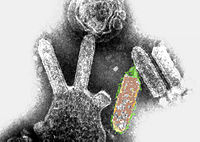
Photo from wikipedia
Marburg viruses (MARVs) cause severe human disease resulting from aberrant immune responses. Dendritic cells (DCs) are primary targets of infection and are dysregulated by MARV. Dysregulation of DCs facilitates MARV… Click to show full abstract
Marburg viruses (MARVs) cause severe human disease resulting from aberrant immune responses. Dendritic cells (DCs) are primary targets of infection and are dysregulated by MARV. Dysregulation of DCs facilitates MARV replication and virus dissemination and influences downstream immune responses that result in immunopathology. Egyptian rousette bats (ERBs) are natural reservoirs of MARV, and infection results in virus replication and shedding, with asymptomatic control of the virus within weeks. The mechanisms that bats employ to appropriately respond to infection while avoiding disease are unknown. Because DC infection and modulation are important early events in human disease, we measured the transcriptional responses of ERB DCs to MARV. The significance of this work is in identifying cell type-specific coevolved responses between ERBs and MARV, which gives insight into how bat reservoirs are able to harbor MARV and permit viral replication, allowing transmission and maintenance in the population while simultaneously preventing immunopathogenesis. ABSTRACT Dysregulated and maladaptive immune responses are at the forefront of human diseases caused by infection with zoonotic viral hemorrhagic fever viruses. Elucidating mechanisms of how the natural animal reservoirs of these viruses coexist with these agents without overt disease, while permitting sufficient replication to allow for transmission and maintenance in a population, is important for understanding the viral ecology and spillover to humans. The Egyptian rousette bat (ERB) has been identified as a reservoir for Marburg virus (MARV), a filovirus and the etiological agent of the highly lethal Marburg virus disease. Little is known regarding how these bats immunologically respond to MARV infection. In humans, macrophages and dendritic cells (DCs) are primary targets of infection, and their dysregulation is thought to play a central role in filovirus diseases, by disturbing their normal functions as innate sensors and adaptive immune response facilitators while serving as amplification and dissemination agents for the virus. The infection status and responses to MARV in bat myeloid-lineage cells are uncharacterized and likely represent an important modulator of the bat’s immune response to MARV infection. Here, we generate DCs from the bone marrow of rousette bats. Infection with a bat isolate of MARV resulted in a low level of transcription in these cells and significantly downregulated DC maturation and adaptive immune-stimulatory pathways while simultaneously upregulating interferon-related pathogen-sensing pathways. This study provides a first insight into how the bat immune response is directed toward preventing aberrant inflammatory responses while mounting an antiviral response to defend against MARV infection. IMPORTANCE Marburg viruses (MARVs) cause severe human disease resulting from aberrant immune responses. Dendritic cells (DCs) are primary targets of infection and are dysregulated by MARV. Dysregulation of DCs facilitates MARV replication and virus dissemination and influences downstream immune responses that result in immunopathology. Egyptian rousette bats (ERBs) are natural reservoirs of MARV, and infection results in virus replication and shedding, with asymptomatic control of the virus within weeks. The mechanisms that bats employ to appropriately respond to infection while avoiding disease are unknown. Because DC infection and modulation are important early events in human disease, we measured the transcriptional responses of ERB DCs to MARV. The significance of this work is in identifying cell type-specific coevolved responses between ERBs and MARV, which gives insight into how bat reservoirs are able to harbor MARV and permit viral replication, allowing transmission and maintenance in the population while simultaneously preventing immunopathogenesis.
Journal Title: mSphere
Year Published: 2019
Link to full text (if available)
Share on Social Media: Sign Up to like & get
recommendations!